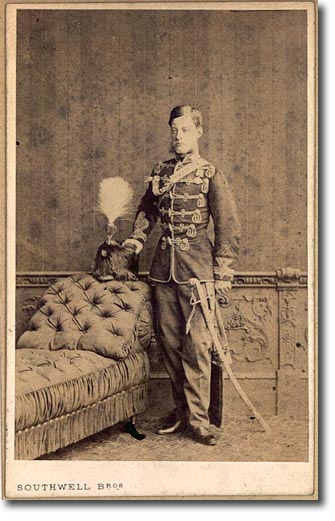|
|

 |
|
This photo is of Captain Horace Montague who had transfered to the 11th from the 8th Hussars in 1857. He wears the uniform that was introduced after the Crimean War to answer the criticisms that uniforms were impractical on active service. The short jacket worn in the Crimea had proved to be a liability in cold weather. The new tunic, which is blue with gold gimp loops, here has long skirts to keep the hips warm. Within a few years the skirts were shortened by a couple of inches. The collar is not closed at the front like other hussar tunics. The front edges slope back to form a V, showing the black stock underneath. This is a tradition maintained in the 11th since 1840 up to modern times. The badges of rank were shown on the collar, in this case a crown and star for a captain. His sleeve decoration also shows his rank, having Russia braid formed into circles around the Austrian knot. The plaiting on his right breast is the distinctive way the 11th looped the gold caplines. He has an Indian Mutiny medal with red and white striped ribbon.
The busby has a formidable white egrette plume which is quite bushy at this stage. The dress regulations for 1855 stipulate a ten inch high plume while the 1864 regulations say 8 inches. This plume, in 1859, seems higher than ten inches. The base of the plume is of crimson vulture feathers. The crimson busby-bag is out of sight hanging on the right side. The trousers are also crimson with a double gold stripe down the side. Hanging from a belt, worn correctly, under his tunic, (see General Wyndham) are a sword and sabretache. The sword is the levee dress mameluke style which suggests that this officer is in levee dress. If so then it is a dismal substitute for the levee dress as worn by Prince Albert in his 1840 portrait. In mounted order the trousers had leathered bottoms which gave the impression of baggy boots. see Officers c1865 In dismounted order the trousers were plain like this. Unfortunately, the dress regulations for 1855 and 1864 do not mention levee dress but certainly the tight breeches and boots were worn in 1876. see Captain Stewart |
Armed Forces | Art and Culture | Articles | Biographies | Colonies | Discussion | Glossary | Home | Library | Links | Map Room | Sources and Media | Science and Technology | Search | Student Zone | Timelines | TV & Film | Wargames
